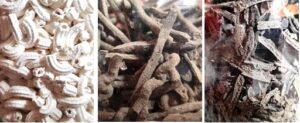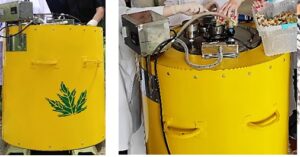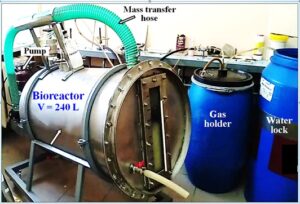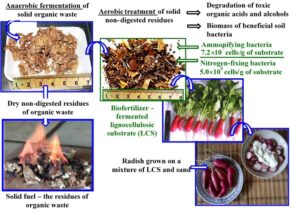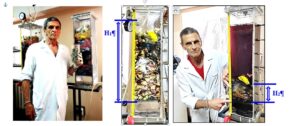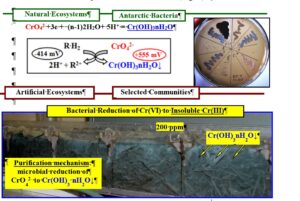Universal bioenergetic and environmental microbial biotechnologies
Prof. Oleksandr Tashyrev
Dr. Vira Hovorukha
Nowadays, environment pollution by solid and liquid organic waste as well as toxic metals is a global problem. The number of landfills and their sizes increases incredibly all over the world. The main part of landfills is the multi component solid food waste (MCSFW) of cities. The MCSFW is decomposed in landfills spontaneously with the production of toxic volatile compounds (ammonia, hydrogen sulphide, mercaptans, volatile organic acids etc.). Moreover, the poisoning filtrate containing a wide range of toxic substances and pathogenic bacteria is produced. The methane accumulation inside of dumps causes collapses and spontaneous fires. Modern environmental technologies (physical, chemical, biological and combined) do not provide effective waste treatment. With the development of industry the amount of metal containing sewage is constantly increasing. The concentration of toxic metals in natural soil and aqueous ecosystems in some cases exceeds permissible values. Therefore, there is a strong need to search for the effective approaches for the treatment of such hazardous waste.
Basing on the thermodynamic calculations we developed the biotechnological approach that provides fast and effective treatment of solid and liquid organic waste as well as metal containing sewage with the obtaining of valuable products (hydrogen, methane, biofertilizer, metal concentrate and purified water). The thermodynamic prediction allows considering all possible pathways of microbial interaction with toxic compounds, choosing the most effective reaction for their treatment as well as regulating of microbial metabolism to provide the optimized process.
The biotechnologies are based on the application of granular microbial preparation (GMP) consisting of highly active microorganisms (Fig. 1). The preparation contains: diversified microbiome; starting energy sources; regulators of microbial metabolism (pH, Eh). It is characterized by the simplicity of application; the ability to degrade a wide range of substrates; the rapid activation of microorganisms and high metabolic activity.
We developed the approach for the following biotechnologies.
- Treatment of multi component solid organic waste.
The dark hydrogen fermentation in the 240 L bioreactors (two modifications) provided 80-120-fold decrease in the weight of solid organic waste during 5-7 days the obtaining of green energy carrier molecular hydrogen (80-120 m3/ton of waste) and also methane (Fig. 2).
The non-digested lignocellulosic residues (50-60 kg/ton of waste) could be used in two ways (Fig. 3). The first one is their direct combustion as a solid fuel. The second one is their additional treatment via aerobic microorganisms to obtain effective biofertilizer.
The developed biotechnologies were successfully implemented at the Ukrainian Antarctic station Akademik Vernadsky (Fig. 4).
- The purification of toxic sewage of waste from soluble organic compounds at the concentration range 10-20 g/L for total Carbon. The 500 times decrease in the concentration of organics as well as obtaining of pure water and methane (0.5-1.0 L / L of sewage). The high efficiency of the process took place due to the application of the spatial succession of physiological groups of bacteria, protozoa, insect larvae, etc. in space under the flow conditions (Fig. 5).
- The approach for accelerated degradation of organic waste of landfills with increased methane yield.
Due to the application of microbial preparations, regulation of microbial metabolism, closed cycle, we have achieved high technological parameters of the degradation of solid organic waste of landfills, methane production and organic filtrate purification (Fig. 6).
In columns simulating a landfill, the weight of solid organic waste 20-fold decreased in just 14 days. The total yield of gaseous energy carriers was: 27 L of hydrogen from 1 kg of waste and methane – 12 L/kg. Further, the concentration of soluble organic compounds was 100-fold reduced in the series-connected methane tanks and air tank (from 2000 to 20 mg/L of total Carbon), and 1 L of CH4 was obtained from each liter of filtrate. Finally, the purified filtrate was supplied to the columns, which significantly improved the fermentation of solid waste. The obtained results create the basis for the use of landfills of household waste as hypermethane tanks, the volume of which is 300 times larger than that of multi-ton biogas plants.
- Purification of sewage from a wide range of toxic metals (Hg2+, CrO42-, Cu2+, Cd2+, Ni2+, Co2+ etc.) at any concentration of metals.
The thermodynamic prediction provided isolation the number of high metal resistant strains and the pathway of the combination of low-potential fermentation of organic waste via obligate anaerobic microorganisms and the reduction of high-potential soluble metal compounds to insoluble ones (Fig. 7).
During hydrogen fermentation of solid waste, the hydrogen-synthesizing microorganisms are a low-potential donor system, and Cr(VI) in the form of CrO42- is a high-potential acceptor system. The difference in standard redox potentials (DЕо¢) between the acceptor and donor systems is 969 mV. Therefore microorganisms quickly and efficiently reduce CrO42- to insoluble hydroxide Cr(ОН)3·nH2O.
Thus, the thermodynamically based approach provides the opportunity to solve the global environmental problems for effective treatment of solid and liquid organic waste as well as metal containing sewage with obtaining of a wide range of valuable (hydrogen, methane, biofertilizer, metal concentrate, purified water).
